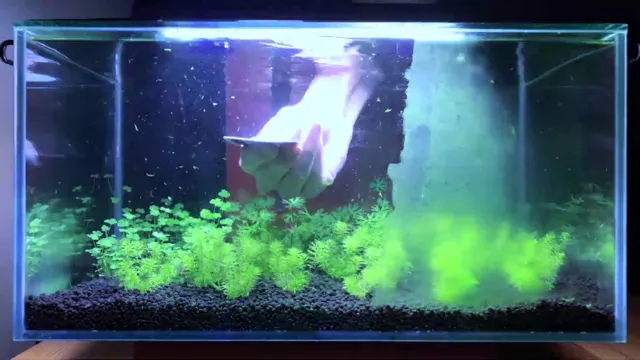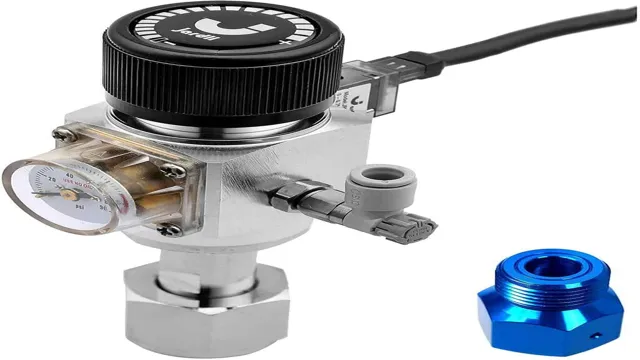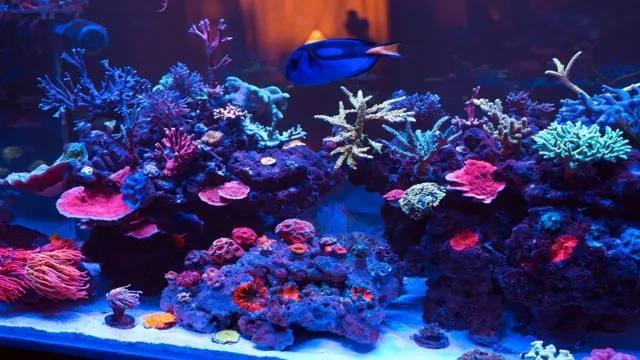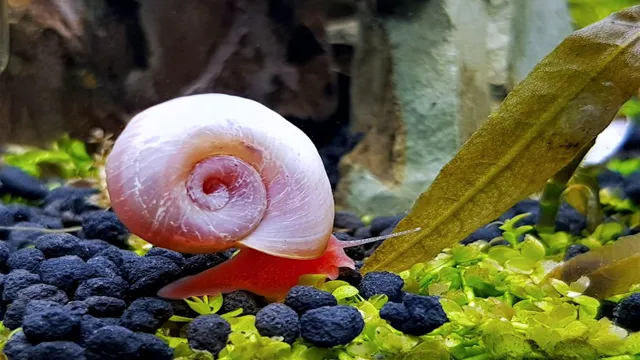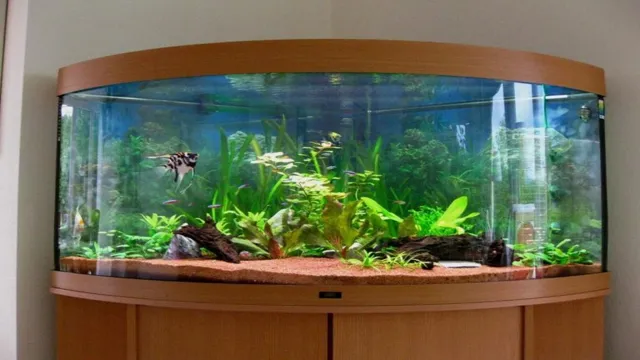If you’re a proud owner of an acrylic aquarium, you know how important it is to keep your aquatic habitat clean and clear. However, no matter how well you maintain your tank, unsightly algae can start growing quickly and cause problems for both your fish and plants. But fear not! Cleaning algae off an acrylic aquarium is a simple task that requires minimal effort.
With the right tools and a bit of elbow grease, you can have your aquarium looking as good as new in no time. So, let’s dive into the best practices for removing algae from your acrylic aquarium and maintaining a healthy environment for your aquatic pets.
Understanding Algae Growth in Acrylic Aquariums
If you’re a new aquarium owner, you may have noticed that your acrylic tank seems to be growing algae at an alarming rate. This is a common issue in aquariums, and luckily there are a few steps you can take to clean it off. First, you’ll want to invest in an algae scrubber or scraper that is specifically designed for use on acrylic tanks – using the wrong tool can scratch or damage the surface of your tank.
You can also try adjusting the lighting and feeding schedule for your fish to reduce the nutrients that promote algae growth. Additionally, consider adding some algae-eating fish or invertebrates to your aquarium to naturally control algae levels. With these tips, you can keep your acrylic aquarium looking beautiful and free of unwanted algae growth.
So go ahead and enjoy your underwater world with crystal-clear views!
Causes of Algae Growth
Algae growth is a common problem in acrylic aquariums, and it can be caused by a variety of factors. One of the primary causes of algae growth is excess light. When an aquarium is exposed to too much light, it can promote the growth of algae.
Another factor that can contribute to algae growth is overfeeding. When too much food is added to the aquarium, it can create a surplus of nutrients that can encourage the growth of algae. Additionally, poor water circulation and not cleaning the aquarium regularly can also lead to the buildup of excess nutrients, which can create an environment that is conducive to algae growth.
It’s important to maintain a balance in the aquarium’s ecosystem to prevent algae growth and ensure the health of your aquatic pets. By keeping a watchful eye on these factors and regularly performing maintenance tasks, you can help regulate algae growth and maintain a healthy, beautiful aquarium.

Types of Algae in Acrylic Aquariums
Acrylic aquariums are a popular choice for fish enthusiasts due to their durability and clarity. However, an unavoidable challenge that comes with owning an acrylic aquarium is dealing with algae growth. Understanding the types of algae that can grow in your aquarium is crucial in creating a healthy and balanced environment for your fish.
There are multiple types of algae that can thrive in acrylic aquariums, including green algae, blue-green algae, brown algae, and red algae. Green algae is the most common type and can appear as a thin film or as stringy hair-like strands. Blue-green algae, also known as cyanobacteria, can be toxic to fish and can produce an unpleasant odor.
Brown algae, commonly known as diatoms, tend to appear on newly established aquariums and can be wiped off easily. Lastly, red algae can have a graceful and elegant appearance with deep red or purple hues but can cause problems with water quality if left unchecked. A combination of factors including excessive light, overfeeding, and poor water quality can contribute to algae growth.
Regular maintenance and monitoring of water conditions can help prevent and control algae growth in acrylic aquariums.
Materials Needed for Cleaning Acrylic Aquarium
If you’re wondering how to clean algae off your acrylic aquarium, there are a few materials you’ll need to get the job done effectively. First and foremost, you’ll want to invest in a high-quality algae scraper designed specifically for acrylic tanks. These tools are made to be gentle on the acrylic surface, preventing scratches or damage to the glass.
You’ll also want to pick up a white vinegar solution, which is an effective and safe cleaner for acrylic surfaces. Additionally, a soft microfiber cloth or sponge will be helpful for gently scrubbing away any remaining algae or dirt. When using these materials, be sure to avoid any harsh chemicals or abrasive tools, as they can damage the acrylic surface or harm your aquatic pets.
With the right materials and care, your acrylic aquarium can stay clean and clear for years to come.
Non-abrasive Cleaning Tools
When it comes to cleaning an acrylic aquarium, using the right cleaning tools is crucial to avoid scratching or damaging the surface. Non-abrasive cleaning tools are the way to go. You will need a soft microfiber cloth, a sponge, and a plastic scraper.
Avoid using abrasive materials such as steel wool, wire brushes, or harsh chemicals that can damage the acrylic surface. A microfiber cloth is great for removing debris and cleaning the outside of the aquarium. A sponge can be used to clean the inside of the aquarium while being gentle enough not to scratch the acrylic.
A plastic scraper is useful for removing stubborn algae and dirt that have built up on the surface. With regular cleaning using these non-abrasive tools, you can keep your acrylic aquarium looking pristine for years to come.
Algae Scrapper
When it comes to cleaning your acrylic aquarium, having the right materials is essential. One handy tool to have in your arsenal is an algae scraper. Algae can quickly build up on the sides of your tank, making it difficult to see your fish and disrupting their habitat. (See Also: How to Make a Simple Aquarium Heater: A Step-by-Step Guide for Beginners)
An algae scraper makes it easy to remove this buildup without damaging the acrylic surface. To effectively clean your tank, you’ll also need a soft, non-abrasive cloth or sponge, a bucket for holding your cleaning solution, and a safe, aquarium-specific cleaning solution. When choosing a cleaning solution, avoid anything that contains ammonia, bleach, or other harsh chemicals that could harm your fish.
With the right materials and a little bit of elbow grease, you can keep your acrylic aquarium looking clean and healthy for your aquatic friends to enjoy.
Algae Pads or Sponges
One of the most important things to consider when it comes to cleaning your acrylic aquarium is the materials you use. Using the wrong kind of cleaning supplies can result in damage to your aquarium and harm to your aquatic pets. One commonly recommended material for cleaning acrylic aquariums is algae pads or sponges.
These materials are gentle enough to not scratch the acrylic surface, yet strong enough to remove any build-up and residue from the glass. Algae pads are typically made from durable synthetic materials, while sponges may be natural or synthetic. When using algae pads or sponges, be sure to moisten them with clean water before using them on your aquarium, and avoid using any harsh chemicals or abrasive scrubbing pads.
By using these materials properly, you can keep your acrylic aquarium looking clean and healthy for your aquatic pets to enjoy.
Acrylic-safe Cleaning Solutions
When it comes to keeping your acrylic aquarium clean, it’s important to use the right materials to avoid any damage. Fortunately, there are several acrylic-safe cleaning solutions available that will do the job without harming your tank. One essential material you’ll need is a microfiber cloth, which is gentle enough to use on acrylic surfaces without scratching.
You should also look for a cleaning solution specifically designed for acrylic, as other cleaners can cause damage or cloudiness. Make sure to avoid using paper towels, sponges with abrasive surfaces, or any cleaning products containing alcohol, ammonia, or bleach. With the right materials and a little elbow grease, you can keep your acrylic aquarium looking spotless and clear.
Step-by-Step Guide to Clean Algae off Acrylic Aquarium
Keeping your aquarium clean is extremely important for the health of your fish and overall aesthetics of your tank. Algae buildup is one of the biggest concerns for aquarium owners. If you have an acrylic aquarium, it’s important to clean algae off properly.
First, make sure to turn off all electrical devices in and around the aquarium to prevent electrical shocks. Secondly, drain the water from the aquarium and completely remove all items from it. Once everything is out, use a soft sponge or cloth to wipe away the algae.
Be careful not to scratch the acrylic surface. If the algae is particularly stubborn, use an algae scraper, making sure to use plastic as metal tools can scratch the acrylic. Once all the algae is removed, rinse everything thoroughly with water and refill the aquarium with appropriate water, adding in any necessary supplements.
Regular maintenance, water changes, and thorough cleaning will keep your aquarium in tip-top shape. By following these steps, your acrylic aquarium will remain healthy and beautiful for both your fish and you to enjoy!
Turn Off all Electrical Components
When it comes to cleaning algae off your acrylic aquarium, it’s important to begin by turning off all electrical components. This means unplugging any filters, heaters, or other devices that are running. Why? Well, first of all, water and electricity don’t mix.
But more importantly, by turning off all electrical components, you will be able to get a clearer view of the algae that you need to clean. It’s much easier to see the algae on a still surface than a moving one! Once everything is turned off and unplugged, you can proceed with the cleaning process. Start by scraping off any excess algae with a plastic scraper, being careful not to scratch the acrylic surface of the tank.
Then, use an algae pad or cloth to scrub away any remaining algae. Be sure to rinse the pad or cloth frequently to prevent spreading the algae around. With a bit of elbow grease and patience, you can easily clean your acrylic aquarium and maintain a beautiful, healthy environment for your fish to thrive in.
Empty the Aquarium
If you’re experiencing an algae problem in your acrylic aquarium, don’t panic! The solution is simpler than you might think. The first step is to remove all the water and the fish from the tank, and then take out any plants or decorations. Next, use a soft, non-abrasive sponge or cloth to gently scrub away the algae.
Be careful not to scratch the acrylic surface, as this can damage your tank. Rinse the aquarium thoroughly with clean water, and then refill it with fresh water and appropriate water conditioner. Make sure to acclimate your fish before putting them back in the tank.
By following these steps, you’ll be able to get rid of the algae and enjoy a clean and healthy aquarium once again. And remember, regular maintenance is key to preventing algae growth in the future!
Scrape Off Excess Algae with Scrapper
Cleaning algae off an acrylic aquarium can seem like a daunting task, but with the right tools and techniques, it’s a straightforward process. When it comes to removing algae, the first step is always to turn off the aquarium equipment. This way, any debris won’t be spread around the tank, and the filter won’t suck in any algae bits. (See Also: How to Make a Profit from Selling Aquarium Fish: Top Tips for Successful Fish Sales)
Once you’ve turned off the equipment, you can start scraping off excess algae with a scraper. Be sure to choose a scraper that’s safe for acrylic aquariums, or you could end up scratching or damaging the surface of the aquarium. A good tip is to start scraping at the top of the tank and work your way down, methodically removing each section of algae.
Don’t forget to angle the scraper and use a little bit of pressure to ensure that the blade is flush against the acrylic and can effectively remove the algae. After you’ve scraped off the excess algae, you can use a soft brush or sponge to gently remove any remaining algae or debris. Start at the top again and work your way down, making sure to be gentle and not scratch the acrylic.
Once you’ve finished cleaning the aquarium, switch the equipment on and enjoy a crystal clear view of your aquatic friends! Remember, keeping up with regular aquarium maintenance can prevent algae buildup, so make sure to schedule regular cleanings to keep your aquarium looking its best.
Clean the Acrylic with Algae Pads and Cleaning Solution
If you’re an aquarium owner, keeping your tank clean is essential to the health of your aquatic plants and animals. Algae buildup can be a common problem in an aquarium, but with a little bit of elbow grease, you can get rid of it. One effective method for cleaning algae off acrylic aquariums is using algae pads and a cleaning solution.
Start by removing any visible debris or waste from the surface of the acrylic with a soft-bristled brush. Then, use the algae pad to gently scrub the surface in a circular motion while spraying a cleaning solution on the area. Avoid using harsh chemicals or rough abrasives as this can scratch or damage the acrylic surface.
Rinse thoroughly with clean water and repeat the process until the algae buildup is gone. It’s important to note that cleaning your aquarium regularly can prevent algae buildup from becoming a bigger issue. So, next time you notice algae growing in your tank, grab some algae pads and cleaning solution and tackle the issue head-on with a little bit of hard work and determination.
Rinse the Acrylic Aquarium Thoroughly
When it comes to cleaning algae off your acrylic aquarium, it’s crucial to start with rinsing it thoroughly. This step will help remove any loose debris or dirt buildup that may have accumulated on the surface of the aquarium. To rinse your aquarium, start by filling a bucket with fresh water, and then immerse your aquarium in it.
Use a sponge or soft-bristled brush to gently scrub the walls of the aquarium, making sure to cover all areas. Rinse the sponge or brush after every few strokes to prevent spreading algae spores. Continue rinsing the aquarium until all signs of dirt and debris are gone.
Once done, you can proceed to the next step of the cleaning process. Remember, rinsing your acrylic aquarium may seem simple, but it’s a crucial step to ensure a clean and clear aquarium for your aquatic pets.
Preventing Algae Growth in Acrylic Aquarium
Algae growth in an acrylic aquarium can be a frustrating problem for many aquarium owners. Cleaning algae off acrylic can sometimes be a tricky task that requires a bit of patience and effort. However, if you take some preventative measures, it will help to greatly reduce the likelihood of algae overtaking your aquarium.
Firstly, ensure that your aquarium is not placed in direct sunlight and that it is not receiving too much artificial light. Excessive light exposure can encourage algae growth. Secondly, be careful not to overfeed your fish as leftover food can contribute to algae buildup.
A good rule of thumb is to feed your fish only as much food as they can consume within 2-3 minutes. Additionally, you should invest in a good quality algae scraper to regularly remove any visible algae growth on the acrylic. Lastly, consider the use of algae-eating fish or algae-eating snails to help keep your aquarium clean.
By taking these preventative measures, you will be able to enjoy a clean and healthy aquarium without the hassle of algae buildup.
Reducing Light Exposure
Reducing light exposure can be a simple yet effective way to prevent algae growth in your acrylic aquarium. Algae thrive in the presence of light, and too much light can lead to an overgrowth of unsightly green or brown algae that can harm the health of your aquatic pets. You can reduce light exposure by adjusting the lighting in your aquarium, such as lowering the intensity or duration of light cycles.
Another option is to add more plants or decorations to your tank, which can help provide shade and limit the amount of light reaching the water. By taking these preventative measures, you can enjoy a clear and healthy aquarium without the hassle of dealing with algae buildup.
Maintaining Proper Water Chemistry
Maintaining proper water chemistry is essential for preventing algae growth in your acrylic aquarium. Algae can be a persistent problem for aquarium hobbyists, especially those with acrylic aquariums. Acrylic is a more porous material than glass, making it easier for algae to attach and grow.
The best way to prevent algae growth in your acrylic aquarium is by maintaining proper water chemistry. This means monitoring the pH, nitrate, and phosphate levels in your aquarium regularly. You can also add live plants to your aquarium to help control algae growth.
Another effective way to prevent algae growth is by limiting the amount of light your aquarium receives. Algae thrive in light, so reducing the amount of light your aquarium receives can help keep algae at bay. By following these tips, you can maintain a clean and healthy acrylic aquarium. (See Also: How to Lower Aquarium pH for Breeding: Simple Tips and Tricks)
Limiting Overfeeding and Fish Load
One of the essential ways of preventing algae growth in an acrylic aquarium is by limiting overfeeding and controlling the fish load. Overfeeding your fish can lead to an excess of uneaten food in the aquarium, which can create a breeding ground for algae. Therefore, it is vital to feed your fish with the appropriate amount of food they need to consume within a specific period.
Additionally, a high fish load can contribute to an increase in waste production, which can lead to algae growth. A good way to control this is by adding fish to the aquarium gradually instead of adding them all at once. This allows the aquarium to adjust slowly, preventing a sudden increase in waste production.
By limiting overfeeding and controlling the fish load, you can promote a healthy and clean environment in your acrylic aquarium without the threat of excessive algae growth.
Regular Maintenance and Cleaning
Acrylic aquariums are a beautiful addition to any home, but maintaining their clarity can be a bit of a challenge. One common issue is the growth of algae on the walls and surfaces of the tank. Preventing algae growth is crucial to preserving the beauty of your aquarium and the health of your fish.
To do this, regular maintenance and cleaning are essential. This includes removing any uneaten food or debris, checking and adjusting the water pH and ammonia levels, and periodically scraping off any algae that may have formed. Additionally, reducing the amount of light that shines on the tank, limiting the amount of nutrients introduced into the water, and adding algae eaters to the tank can all help prevent algae growth.
With proper maintenance and a little effort, you can keep your acrylic aquarium looking beautiful and healthy for years to come.
Conclusion
When it comes to cleaning algae off your acrylic aquarium, there’s no need to dive deeper into frustration! Thanks to these simple steps, your tank can go from murky to sparkling in no time. Keep your fishy friends happy and healthy by giving them a clean and clear home. Don’t let algae take over – tackle the problem head on! Trust us, a little elbow grease now will save you from future algae woes.
So grab your scrubber and get ready to make your aquarium shine bright like a diamond!”
FAQs
What are the causes of algae growth in an acrylic aquarium?
Algae growth can be caused by a variety of factors including excessive light, overfeeding, lack of water changes, and poor water quality.
How often should I clean the algae off my acrylic aquarium?
It is recommended to clean the algae off of your aquarium every 1-2 weeks, depending on the severity of the algae growth.
What is the best way to clean algae off an acrylic aquarium?
The best way to clean algae off of an acrylic aquarium is to use a soft-bristled brush or an algae scraper. Avoid using abrasive sponges or materials that can scratch the surface of the acrylic.
Can algae growth harm my aquarium fish?
While some types of algae can provide beneficial nutrients for fish, an overgrowth of algae can harm fish by reducing the amount of oxygen in the water and lowering the pH level.
What should I do if the algae growth is excessive and difficult to remove?
If the algae growth is excessive and difficult to remove, you may need to use an algae treatment product or seek the advice of a professional aquarium maintenance service.
How can I prevent algae growth in my acrylic aquarium?
Algae growth can be prevented by controlling the amount of light, avoiding over-feeding, maintaining good water quality, and performing regular water changes.
Is it safe to use chemicals to clean algae off of my acrylic aquarium?
It is recommended to avoid using harsh chemicals or cleaning agents on your acrylic aquarium as they can damage the surface and harm your fish. Stick to natural or aquarium-specific cleaning products.

